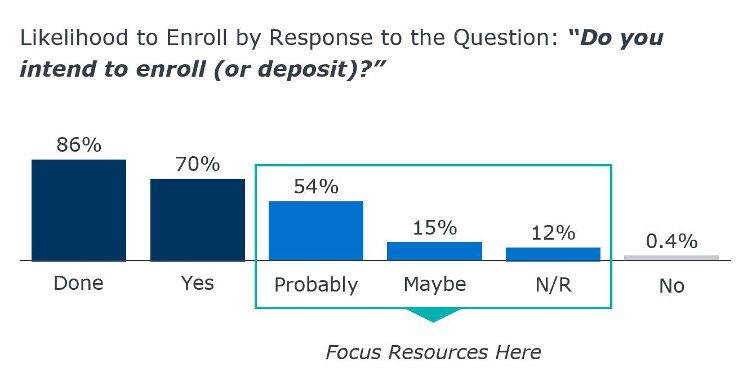Are you losing grad and adult enrollments at the last minute? Try these 4 strategies.
While many institutions follow a robust yield playbook for their undergraduate programs, I’ve found this isn’t always the case for graduate and adult education programs.
Developing an effective yield strategy is just as important at the graduate level, if not more so. Many prospective adult students are not only considering different program options, but also weighing going back to school against other priorities such as work and family—meaning their enrollment decisions are constantly in flux. Yield is also a year-round problem at the graduate level, with many programs admitting students for multiple start dates.
Here are a few tactics to convert as many admits to enrollments as possible.
1. Use deadline campaigns to drive deposits
One of my favorite strategies to improve conversion from admit to enrollment is to offer multiple admissions deadlines for your programs. Application deadlines always build a sense of urgency among prospective students—multiple application deadlines create multiple periods of urgency throughout the enrollment cycle.
Adults need reminders, too. Our Adult Learner Recruitment team has found that setting at least two deadlines to drive early enrollment, deposit, or registrant activity works best. I’ve seen our partners have the most success when they set a deadline one month before the last date a prospect can confirm their enrollment and a second date on the true, final deadline for enrollment. Ideally, you can offer an incentive for students to enroll at the earlier deadline, such as, “This is the recommended deadline to ensure your first pick of classes” or “first pick of housing.” Remember to clearly articulate the steps for confirming enrollment when marketing your deadlines.
2. Survey admitted students to understand their enrollment intentions
Forecasting enrollment is a perennial challenge for leaders of graduate and adult-serving programs. Surveying students about their intent to enroll allows you to understand how your class is shaping up a little bit easier. My team deploys surveys to admitted students on behalf of our Adult Learner Recruitment partners to understand the likelihood a student will choose their institution. The survey enables enrollment leaders to identify the students who do not plan to enroll, allowing their admissions teams to focus on students still on the fence about enrolling who might benefit from an additional admissions touch. On average, we see about 14% of respondents indicate they will “probably” or “maybe” enroll. Sixty-five percent of those students say they need more information, such as details about financial aid and overall cost, to make an enrollment decision.
Survey Responses Help Identify High-Priority Admits for Outreach

Students who say they do not plan to enroll at your institution rarely change their mind, so it’s often not worth focusing resources on changing their minds. Instead, ask those students why they didn’t choose your institution. The reasons students say they chose another institution—perhaps a more competitive financial aid package elsewhere, a shorter time-to-completion, or more promising student outcomes—can help inform changes to your recruitment strategy or even to your academic programs. And ask those students where they are enrolling instead to uncover competitors you may have previously overlooked.
For example, I work with an institution who noticed that their melt was higher than in past years. When looking at the responses from students who indicated they did not intend to enroll, this institution noticed that a particular school kept coming up as the destination institution. When comparing themselves to this other institution, this school found that they were losing students because the other institution had a more competitive price point. This insight inspired the school we worked with to go back out with a repackaged scholarship offer.
The ability to direct enrollment and admissions resources where they will have the greatest impact is especially important given the talent shortage plaguing enrollment offices at institutions of all types. In a recent survey of 500+ graduate enrollment managers, 57% of respondents said they are considering leaving their current position.
3. Identify and clearly communicate your value proposition to admitted students
I always say an applicant or admit is still an inquiry until they show up on campus (or in the virtual classroom), so it’s important to keep recruiting students even after they have been admitted. The most important message you can deliver to students at this stage is your institution’s unique value proposition and evidence of student success. Your value proposition could be your standout corporate partnerships, student outcomes, services to support graduate students, or a unique aspect of your institutional culture. Continue to send admitted students stories from successful current students and alumni. Prospects want to see themselves in your students and hear directly from students about your institution’s value.
“Given their early communication with prospective and newly admitted students, higher education offices that specialize in marketing, recruitment, and business processes are at the front lines of providing information about institutional culture. Intentionally and transparently communicating culture through email should be an essential goal when these offices construct their communication plans.”
Candice Wilson-Stykes, “Understanding an Institution’s Culture”
4. Encourage faculty to engage with admitted students
Faculty are often an underutilized resource in marketing and recruitment, but their support can be especially helpful in converting admits to enrollments. Surveyed adult learners identified faculty expertise and reputation as an important factor when making an enrollment decision. Faculty are also one of the reasons why students choose their institution. Faculty are the rock stars on campus, and prospects want to know them and learn from them. Elevating faculty expertise and giving prospects an opportunity to get to know them and learn from them before enrolling is a secret to success. Invite faculty to join admitted student events, or work with your marketing team to contact top admits directly via phone or email. And continue to highlight faculty expertise throughout the recruitment process via faculty profiles on your website and social media channels.
As always, ensure you have visibility into the enrollment funnel—from awareness to decision and enrollment—to understand where you’re losing students. Our Adult Learner Recruitment partners have 24/7 access to our Insights Dashboard, where they can see how leads are converting at every stage of the funnel. We’ve found that closely tracking funnel metrics and implementing a few simple yield tactics can make a significant difference in converting admits to enrollments.
Ready to find out more?
Hear more tactics to increase yield in your graduate and adult-serving programs.

More Blogs

Adult learners: who they are and what they want from college

4 questions domestic students will ask before applying to your graduate program
